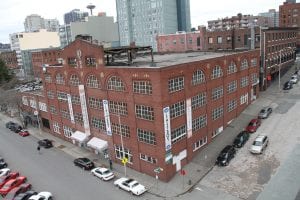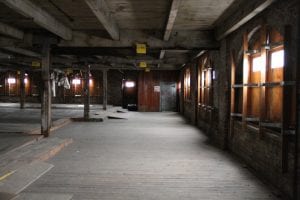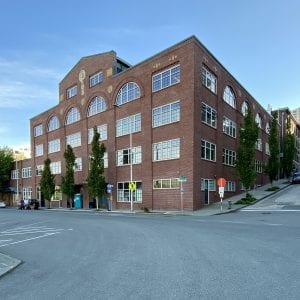Heart This Place: Union Stables
By Jeff Murdock
To celebrate Preservation Month from home, we have launched Heart This Place – a new blog series from Historic Seattle staff. Each post will feature a different place that is significant to a member of our staff. First up is Advocacy & Education Manager Jeff Murdock:

The Union Stables building as it appeared in 2011
After working for several years in my hometown in suburban Los Angeles, I made my way back to Seattle in 2007. We moved into to a fixer-upper apartment just up Western Avenue from Pike Place Market, situated diagonally across the street from the Union Stables building. At that time, these two buildings anchored a difficult block of Western Avenue. Surrounded by nefarious parking lots, with the viaduct walling off Western a half block north and the Battery Street tunnel ushering traffic north, it was easy to miss the historic building. It didn’t help that the mostly vacant property had been boarded up with plywood decorated with painted-on window details and garish multi-story banners advertising the property owner’s furniture business.

An interior view of the Union Stables building, 2011
But the intriguing urban stables did invite further investigation. I have always felt that there are a few old buildings in any neighborhood which, even after being ignored for decades and falling into the background of the city, can still convey a sense of memory and history – even as they wait precariously for a new life. To the casual observer, this was clearly once a working building – with its massive red brick masonry structure expressed in piers, large Roman arches, and expansive window openings. A curiously large pedimented parapet on Western is detailed with a telltale horse’s head, in terracotta. I had the opportunity to tour the ghostly interior of the building a couple years after we moved to the neighborhood. Walking through the massive horse-gnawed timber structure, it was easy to understand the layout of the stables, how horses moved through the building, and where they would spend their days waiting to convey their empty wagons home to the farms that supplied the public markets. You could imagine the heavy clip-clop of hoofs striking the substantial decking and alfalfa bales being lifted to the rooftop barn. But I don’t think it was my imagination bringing about the sensation of an odor of “agriculture,” that is, horse urine.

The terracotta horse’s head, 2011
In earlier-developed eastern cities, urban stables are a more common component of the built environment – reflecting the era when horsepower meant “powered by a horse.” Before the automobile’s transformative impact on urban design, cities developed with fashionable shopping streets offset by gritty working streets, which included urban stables as a building type. These working streets with their adapted stables would later provide the artist lofts and warehouse offices which contribute to many of our richest historic urban neighborhoods.
The Union Stables building was designed by George Dietrich and was constructed in 1910, not long after the Pike Place Market was founded. Accommodating over 300 horses, it was the largest of several stables constructed on Western Avenue (another one across the street from us is now occupied by Cloudburst Brewing, indicative of our changing neighborhood). A Seattle Daily Times article called it “the most modern stable west of the Mississippi.” However, it was built toward the end of the era of horse-drawn transportation in Seattle. By the early 1920s, the automobile had largely replaced equestrian transport in Seattle. The Union Stables’ robust construction and interior ramps allowed the building to be converted for various automotive uses. Over the years, the building intermittently served as a towing garage, furniture warehouse, and was even the location of an illicit cache of prohibition-era bootleg liquor, “the largest stock ever unearthed by police.” But its occupancy and uses dwindled over the years, and by the time we moved to the neighborhood the building was long empty.

The Union Stables building as it appears today
Today, our neighborhood is almost unrecognizable from when we moved here. The viaduct has disappeared, creating views that draw pedestrians north from Pike Place Market. Parking lots once noteworthy for being locations of illegal drug trade and nighttime gunfire are gradually becoming sites for high-end apartment development. Still, the Union Stables building holds court on our block. In 2013, the property was listed on the National Register of Historic Places and also became a City of Seattle designated landmark. Skillfully rehabilitated in recent years, the building is still occupied by stalls of daily workers – in architecture, construction, and technology.